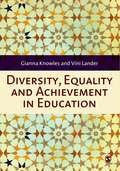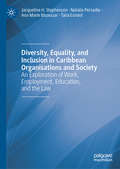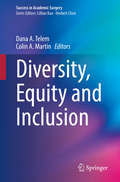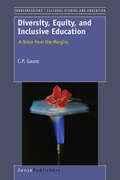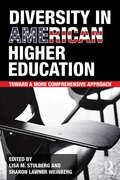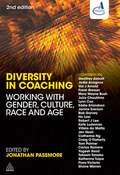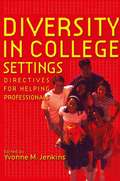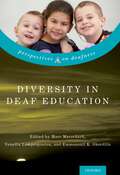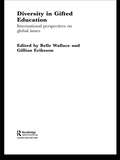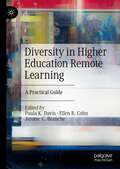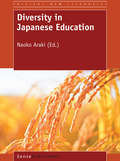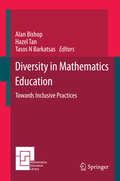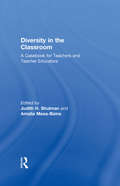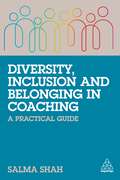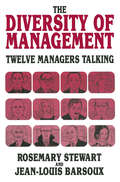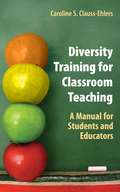- Table View
- List View
Diversity, Equality and Achievement in Education
by Gianna Knowles Mrs Vini LanderMost classrooms contain children from a variety of backgrounds, where home culture, religious beliefs and the family's economic situation all impact on achievement. This needs to be recognised by teachers in order to establish fair, respectful, trusting and constructive relationships with children and their families, which will allow every child to reach their full potential. This book looks at real issues that affect teachers in the classroom, and examines a variety of influences affecting child development. It provides you with the theoretical and practical information you need to ensure you understand the complex factors which affect the children in your care, and it encourages good, thoughtful teaching. Dealing with some of the less widely addressed aspects of diversity and inclusion, the book considers: - children who are asylum seekers - the notion of 'pupil voice' - what diversity and equality mean in practice - gender and achievement - looked-after children - social class - disability - ethnicity and whiteness This book is essential reading for any education student looking at diversity and inclusion, and for teachers in role looking for advice on how to meet the professional standards.
Diversity, Equality and Achievement in Education
by Gianna Knowles Vini LanderMost classrooms contain children from a variety of backgrounds, where home culture, religious beliefs and the family's economic situation all impact on achievement. This needs to be recognised by teachers in order to establish fair, respectful, trusting and constructive relationships with children and their families, which will allow every child to reach their full potential. This book looks at real issues that affect teachers in the classroom, and examines a variety of influences affecting child development. It provides you with the theoretical and practical information you need to ensure you understand the complex factors which affect the children in your care, and it encourages good, thoughtful teaching. Dealing with some of the less widely addressed aspects of diversity and inclusion, the book considers: - children who are asylum seekers - the notion of 'pupil voice' - what diversity and equality mean in practice - gender and achievement - looked-after children - social class - disability - ethnicity and whiteness This book is essential reading for any education student looking at diversity and inclusion, and for teachers in role looking for advice on how to meet the professional standards.
Diversity, Equality and Achievement in Education (2nd edition) (PDF)
by Gianna KnowlesMost classrooms contain children from a variety of backgrounds, where home culture, religious beliefs and the family's economic situation all impact on achievement. This needs to be recognised by teachers in order to establish fair, respectful, trusting and constructive relationships with children and their families, which will allow every child to reach their full potential. This book looks at real issues that affect teachers in the classroom, and examines a variety of influences affecting child development. It provides you with the theoretical and practical information you need to ensure you understand the complex factors which affect the children in your care, and it encourages good, thoughtful teaching. Dealing with some of the less widely addressed aspects of diversity and inclusion, the book considers: - children who are asylum seekers - the notion of 'pupil voice' - what diversity and equality mean in practice - gender and achievement - looked-after children - social class - disability - ethnicity and whiteness This book is essential reading for any education student looking at diversity and inclusion, and for teachers in role looking for advice on how to meet the professional standards. 9781849206013
Diversity, Equality and Achievement in Education (PDF)
by Gianna Knowles Mrs Vini LanderMost classrooms contain children from a variety of backgrounds, where home culture, religious beliefs and the family's economic situation all impact on achievement. This needs to be recognised by teachers in order to establish fair, respectful, trusting and constructive relationships with children and their families, which will allow every child to reach their full potential. This book looks at real issues that affect teachers in the classroom, and examines a variety of influences affecting child development. It provides you with the theoretical and practical information you need to ensure you understand the complex factors which affect the children in your care, and it encourages good, thoughtful teaching. Dealing with some of the less widely addressed aspects of diversity and inclusion, the book considers: - children who are asylum seekers - the notion of 'pupil voice' - what diversity and equality mean in practice - gender and achievement - looked-after children - social class - disability - ethnicity and whiteness This book is essential reading for any education student looking at diversity and inclusion, and for teachers in role looking for advice on how to meet the professional standards.
Diversity, Equality, and Inclusion in Caribbean Organisations and Society: An Exploration of Work, Employment, Education, and the Law
by Jacqueline H. Stephenson Natalie Persadie Ann Marie Bissessar Talia EsnardThis book focuses on equality, inclusion, and discrimination within the English-speaking Caribbean region, specifically as it relates to employment, education, society, and the law. Though anti-discrimination laws have recently been enacted in the Caribbean, this, in and of itself, neither translates to societal changes nor changes within the organisational context. The authors examine racial diversity in public sector organisations in Trinidad and Tobago and Guyana, gender diversity in organisations across the Caribbean region, sexual orientation and its impact on employment, disability and access within organisations, and equality and inclusion within Caribbean institutions of higher education. Further, the book explores the region’s equality laws and compares them with legislation from selected developed countries. This interdisciplinary text provides researchers in HRM, organisational behavior, sociology, and public policy with an overview of the types of discrimination prevalent within the Caribbean as well as the varied institutional frameworks in place that encourage equality.
Diversity, Equity and Inclusion (Success in Academic Surgery)
by Dana A. Telem Colin A. MartinThis book comprehensively covers diversity, equity and inclusion (DEI) in the context of daily surgical practice. Through real-life illustrative case scenarios and experiences, this book explores DEI and its impact on academic surgery, career development, and clinical practice. Each chapter highlights a commonly encountered scenario and features extensive guidance on how to address each challenge secondary to both implicit explicit biases as well as detailing how to implement best practices. Diversity, Equity and Inclusion provides a detailed guide to the best practices and challenges associated with implementing DEI in day to day surgical practice and is a valuable resource for all surgical practitioners looking for a guide on how to successfully implement DEI strategies into daily clinical practice.
Diversity, Equity, and Inclusive Education: A Voice From The Margins (Transgressions #65)
by C.P. GauseThe United States is more ideologically, philosophically, culturally, linguistically, racially, and ethnically diverse than she has been in any given point in her history; however, many of her citizens are currently living in a state of fear. What stands out the most is how we allow this fear to take over our lives in multiple ways. We fear our neighbors; therefore, we do not engage them. We fear young people and the way they look; therefore, we do not have conversations with them. We fear the possibility of terrorists’ attacks; therefore, we utilize eavesdropping and surveillance devices on our citizens. There are some of us who fear the lost of gun rights; therefore, we stockpile weapons. We fear anything that is different from who we are and what we believe. This nation has, at many points within our history, become more united because of our fear; however, as our borders, physical and virtual, become less protective and the opportunities to connect more via the digital world expand, we must educate our citizenry to not live in fear but in hope. To teach, learn, and lead democratically requires the individual to engage in problem posing and in critiquing taken-for-granted narratives of power and privilege. Critical change occurs with significant self-sacrifice, potential alienation/rejection, and costly consequences. Educators must do justice to the larger social, public, and institutional responsibility of our positions, and we must exercise courage in creating opportunities for change. Diversity, Equity, and Inclusive Education: A Voice from the Margins, provides the space and opportunity to move beyond a state of fear, into a state of “organic transformation,” a place where fear creates the energy to speak those things that are not, as though they were.
Diversity in American Higher Education: Toward a More Comprehensive Approach
by Lisa M. Stulberg Sharon Lawner WeinbergDiversity has been a focus of higher education policy, law, and scholarship for decades, continually expanding to include not only race, ethnicity and gender, but also socioeconomic status, sexual and political orientation, and more. However, existing collections still tend to focus on a narrow definition of diversity in education, or in relation to singular topics like access to higher education, financial aid, and affirmative action. By contrast, Diversity in American Higher Education captures in one volume the wide range of critical issues that comprise the current discourse on diversity on the college campus in its broadest sense. This edited collection explores: legal perspectives on diversity and affirmative action higher education's relationship to the deeper roots of K-12 equity and access policy, politics, and practice's effects on students, faculty, and staff. Bringing together the leading experts on diversity in higher education scholarship, Diversity in American Higher Education redefines the agenda for diversity as we know it today.
Diversity in American Higher Education: Toward a More Comprehensive Approach
by Lisa M. Stulberg Sharon Lawner WeinbergDiversity has been a focus of higher education policy, law, and scholarship for decades, continually expanding to include not only race, ethnicity and gender, but also socioeconomic status, sexual and political orientation, and more. However, existing collections still tend to focus on a narrow definition of diversity in education, or in relation to singular topics like access to higher education, financial aid, and affirmative action. By contrast, Diversity in American Higher Education captures in one volume the wide range of critical issues that comprise the current discourse on diversity on the college campus in its broadest sense. This edited collection explores: legal perspectives on diversity and affirmative action higher education's relationship to the deeper roots of K-12 equity and access policy, politics, and practice's effects on students, faculty, and staff. Bringing together the leading experts on diversity in higher education scholarship, Diversity in American Higher Education redefines the agenda for diversity as we know it today.
Diversity in Coaching: Working with Gender, Culture, Race and Age
by Jonathan PassmorePublished with the Association for Coaching, Diversity in Coaching explores the impact and implication of difference in coaching. The book looks at how coaches can respond to issues of gender, generational, cultural, national and racial difference. Understanding how diversity impacts upon coaching is a crucial element to coaching effectively in today's diverse society and can give coaches the edge when responding to their coachees need.Written by an international team of coaching professionals, the book provides guidance on understanding diversity and how coaches can adapt coaching styles and techniques to meet individual needs, local demands and cultural preferences.It explores the impact and implication of difference in coaching, providing practical information to help coaches respond effectively to issues of diversity.
Diversity in Coaching: Working with Gender, Culture, Race and Age
by Jonathan PassmorePublished with the Association for Coaching, Diversity in Coaching explores the impact and implication of difference in coaching. The book looks at how coaches can respond to issues of gender, generational, cultural, national and racial difference. Understanding how diversity impacts upon coaching is a crucial element to coaching effectively in today's diverse society and can give coaches the edge when responding to their coachees need.Written by an international team of coaching professionals, the book provides guidance on understanding diversity and how coaches can adapt coaching styles and techniques to meet individual needs, local demands and cultural preferences.It explores the impact and implication of difference in coaching, providing practical information to help coaches respond effectively to issues of diversity.
Diversity in College Settings: Directives for Helping Professionals
by Yvonne M. JenkinsFirst Published in 1999. Routledge is an imprint of Taylor & Francis, an informa company.
Diversity in College Settings: Directives for Helping Professionals
by Yvonne M. JenkinsFirst Published in 1999. Routledge is an imprint of Taylor & Francis, an informa company.
Diversity in Deaf Education (Perspectives on Deafness)
by Marc Marschark and Venetta Lampropoulou Emmanouil K. SkordilisDeaf children are not hearing children who can't hear. Beyond any specific effects of hearing loss, as a group they are far more diverse than hearing peers. Lack of full access to language, incidental learning, and social interactions as well as the possibility of secondary disabilities means that deaf learners face a variety of challenges in academic domains. Technological innovations such as digital hearing aids and cochlear implants have improved hearing and the possibility of spoken language for many deaf learners, but parents, teachers, and other professionals are just now coming to recognize that there are cognitive, experiential, and social-emotional differences between deaf and hearing students likely to affect academic outcomes. Sign languages and schools and programs for deaf learners thus remain an important part of the continuum of services needed for this diverse population. Understanding such diversity and determining ways in which to accommodate them must become a top priority in educating deaf learners. Through the participation of an international, interdisciplinary set of scholars, Diversity in Deaf Education takes a broad view of learning and academic progress, considering "the whole child" in the context of the families, languages, educational settings in which they are immersed. In adopting this perspective, the complexities and commonalities in the social, emotional, cognitive, and linguistic mosaic of which the deaf child is a part, are captured. It is only through such a holistic consideration of diverse children developing within diverse settings that we can understand their academic potentials.
Diversity in Deaf Education (Perspectives on Deafness)
Deaf children are not hearing children who can't hear. Beyond any specific effects of hearing loss, as a group they are far more diverse than hearing peers. Lack of full access to language, incidental learning, and social interactions as well as the possibility of secondary disabilities means that deaf learners face a variety of challenges in academic domains. Technological innovations such as digital hearing aids and cochlear implants have improved hearing and the possibility of spoken language for many deaf learners, but parents, teachers, and other professionals are just now coming to recognize that there are cognitive, experiential, and social-emotional differences between deaf and hearing students likely to affect academic outcomes. Sign languages and schools and programs for deaf learners thus remain an important part of the continuum of services needed for this diverse population. Understanding such diversity and determining ways in which to accommodate them must become a top priority in educating deaf learners. Through the participation of an international, interdisciplinary set of scholars, Diversity in Deaf Education takes a broad view of learning and academic progress, considering "the whole child" in the context of the families, languages, educational settings in which they are immersed. In adopting this perspective, the complexities and commonalities in the social, emotional, cognitive, and linguistic mosaic of which the deaf child is a part, are captured. It is only through such a holistic consideration of diverse children developing within diverse settings that we can understand their academic potentials.
Diversity in Gifted Education: International Perspectives on Global Issues
by Gillian Eriksson Belle WallaceThis timely book brings together experts from around the world to share expertise and best practice to form an eclectic collection of the best approaches for teaching gifted and talented children from different cultures. Each chapter: presents an overview of international perspectives on the issues of multi-cultural and gifted education examines the critical issues related to cultural definitions of giftedness in programming for diverse gifted students presents regional case studies in order to inform practitioners' best practice examines issues of access for gifted students in relation to culture, poverty, race and gender. In addition, details of websites and associations which offer support and advice are also provided, making this book an invaluable resource for academics, researchers, teachers and parents of gifted and talented children.
Diversity in Gifted Education: International Perspectives on Global Issues
by Belle Wallace Gillian ErikssonThis timely book brings together experts from around the world to share expertise and best practice to form an eclectic collection of the best approaches for teaching gifted and talented children from different cultures. Each chapter: presents an overview of international perspectives on the issues of multi-cultural and gifted education examines the critical issues related to cultural definitions of giftedness in programming for diverse gifted students presents regional case studies in order to inform practitioners' best practice examines issues of access for gifted students in relation to culture, poverty, race and gender. In addition, details of websites and associations which offer support and advice are also provided, making this book an invaluable resource for academics, researchers, teachers and parents of gifted and talented children.
Diversity in Higher Education Remote Learning: A Practical Guide
by Paula K. Davis Ellen R. Cohn Jerome C. BrancheThis book provides fundamental principles of remote instruction and classroom management for diversity. Chapters explore the requisite characteristics of higher education administration and infrastructure that support both online and hybrid learning. It draws on proven practices to help research intensive faculty, instructional and clinical faculty, and adjunct faculty deliver efficient and effective online class construction for today's classrooms.
Diversity in Japanese Education (Critical New Literacies: The Praxis of English Language Teaching and Learning (PELT))
by Naoko ArakiNo one is born fully-formed: it is through self-experience in the world that we become what we are. – Paulo Freire Diversity in Japanese Education explores ‘self-experience’ of individual learners and educators in Japan. The word ‘diversity’ is not limited to one’s ethnic background. Here, diversity refers to one’s pedagogical experiences and life experiences; to the norms, beliefs and values that impact such relations. These experiences and relations are fluid as they are shaped and reshaped in global and glocal settings. They are also reflected in praxis of English language learning and teaching in Japan. The authors’ educational backgrounds vary but they all share the common ground of being educators in Japan. Through being involved in learning and/or teaching English language in Japan, they have witnessed and experienced ‘diversity’ in their own pedagogical context. The book focuses on shifting critical and reflexive eyes on qualitative studies of pedagogical experiences rather than presenting one ‘fixed’ view of Japanese education.
Diversity in Mathematics Education: Towards Inclusive Practices (Mathematics Education Library #113)
by Alan Bishop Hazel Tan Tasos N BarkatsasThis book presents a research focus on diversity and inclusivity in mathematics education. The challenge of diversity, largely in terms of student profiles or contextual features, is endemic in mathematics education, and is often argued to require differentiation as a response. Typically different curricula, text materials, task structures or pedagogies are favoured responses, but huge differences in achievement still result. If we in mathematics education seek to challenge that status quo, more research must be focussed not just on diversity but also on the inclusivity, of practices in mathematics education. The book is written by a group of experienced collaborating researchers who share this focus. It is written for researchers, research students, teachers and in-service professionals, who recognise both the challenges but also the opportunities of creating and evaluating new inclusive approaches to curriculum and pedagogy – ones that take for granted the positive values of diversity. Several chapters report new research in this direction. The authors are part of, or have visited with, the mathematics education staff of the Faculty of Education at Monash University, in Melbourne, Australia. The chapters all focus on the ideas of development in both research and practice, recognising that the current need is for new inclusive approaches. The studies presented are set in different contexts, including Australia, China, the United States, and Singapore.
Diversity in the Classroom: A Casebook for Teachers and Teacher Educators
by Judith H. Shulman Amalia Mesa-BainsThis casebook is part of a nationwide effort to capture and use practitioner knowledge to better prepare teachers for the reality of today's classrooms, given a student population vastly different from that of even a decade ago. Consciously designed to provoke engaging and demanding discussion, the cases presented here are candid, dramatic, highly readable accounts of teaching events or series of events. Set in three of the nation's most diverse cities -- San Francisco, Los Angeles, and Phoenix -- the cases offer problem-based snapshots of on-the-job dilemmas. The teacher-authors discuss topics that generate heated interchange and run the risk of polarizing opinions and creating defensive assumptions, particularly those dealing with bias, race, and class. These issues, plus cultural behaviors and socioeconomic circumstances have important implications for classroom practices. By examining such issues, the editors hope that educators will see -- and act on -- the need for a greater variety of teaching styles, distribution of opportunities, and educational access for all students.
Diversity in the Classroom: A Casebook for Teachers and Teacher Educators
by Judith H. Shulman Amalia Mesa-BainsThis casebook is part of a nationwide effort to capture and use practitioner knowledge to better prepare teachers for the reality of today's classrooms, given a student population vastly different from that of even a decade ago. Consciously designed to provoke engaging and demanding discussion, the cases presented here are candid, dramatic, highly readable accounts of teaching events or series of events. Set in three of the nation's most diverse cities -- San Francisco, Los Angeles, and Phoenix -- the cases offer problem-based snapshots of on-the-job dilemmas. The teacher-authors discuss topics that generate heated interchange and run the risk of polarizing opinions and creating defensive assumptions, particularly those dealing with bias, race, and class. These issues, plus cultural behaviors and socioeconomic circumstances have important implications for classroom practices. By examining such issues, the editors hope that educators will see -- and act on -- the need for a greater variety of teaching styles, distribution of opportunities, and educational access for all students.
Diversity, Inclusion and Belonging in Coaching: A Practical Guide
by Salma ShahCoaching and developing employees is not a one size fits all activity. Race, gender, class, education, culture and religion can all affect the needs of employees. Coaches, leaders and line managers must address this.Diversity, Inclusion and Belonging in Coaching is a practical guide for coaches, leaders and line managers which explains how to understand different employee needs, identify what experiences can impact these needs and shows how to develop a truly inclusive approach to coaching and employee development. It also covers how to recognize the difference between employees in survival mode as opposed to those who are thriving, feeling psychologically safe and displaying healthy resilience. Packed full of practical tips, tools, case studies, interviews, examples and activities to work through in practice, this book allows coaches, leaders and line managers to create an inclusive culture of belonging and psychological safety to ensure that all employees flourish. There is also specific guidance on how to deal with employee trauma such as prejudice, racism, bullying, burnout, imposter syndrome and grief as well as how to cultivate a system of acceptance and encourage all employees to safely bring their authentic selves to work. Supported by expert advice, personal experience and industry research, this book is crucial reading for all coaches, leaders and managers responsible for talent development.
The Diversity of Management: Twelve Managers Talking
by Jean-Louis Barsoux Rosemary StewartTwelve lively accounts are given, based on searching interviews, of very different kinds of managerial jobs. They paint a picture of what the job is like, the work that the individual does, and how he or she feels about it. The jobs are compared and lessons are drawn for career guidance, selection and management development as well as how far managerial skills are transferable. The accounts can also be used as case studies and questions are provided for students.
Diversity Training for Classroom Teaching: A Manual for Students and Educators
by Caroline S. Clauss-EhlersAcknowledgements Section 1. Foundations 3 Chapter 1. Introduction: How to Use this Manual.. ................... Chapter 2. How Do We Understand Difference?. ...................... 17 Section 2. Dimensions of Difference: Culture, Socioeconomic Status, Race, Ethnicity, Language, and Parental Partnership 29 Chapter 3. Cultural Values and Worldview.. ............................ Chapter 4. Socioeconomic Status.. ....................................... 4 1 ............................................ 5 1 Chapter 5. Race and Ethnicity.. Chapter 6. Language in the Classroom.. .................................. 67 Chapter 7. Working with Diverse Families: Parental Partnership in Education.. ........................................ 8 1 viii Table of Contents Section 3 . Dimensions of Difference: Gender Chapter 8 . Gender ............................................................ Chapter 9 . Sexual Orientation and Youth ................................. Section 4 . Other Challenges to Diversity Chapter 10 . Bullying in Schools ............................................. Chapter 1 1 . Creating Community through Classroom Management .. Chapter 12 . Child Abuse and Resilience .................................. Section 5 . Understanding Exceptional Microcultures Chapter 13 . Exceptional Microcultures: Dealing with Trauma ...... Chapter 14 . Exceptional Microcultures: Youth with Emotional Disturbance- Childhood Depression. Eating Disorders .................. Chapter 15 . Exceptional Microcultures: How to Make a Referral .. Section 6 . Conclusion Chapter 16 . Conclusion: The Multicultural Educator .................. Selected Bibliography ...................................................... Glossary of Terms ........................................................... Appendix A . Sample Course Syllabus .................................... Appendix B . Educational Intervention Proposal Paper ................. Index ............................................................................ Diversity Training for Classroom Teaching: A Manual for Students and Educators is an excellent guide for preparing responsive teachers, capable of exploring the roots of a wide variety of types of diversity and acting with knowledge and sensitivity to improve student learning and self-efficacy.
